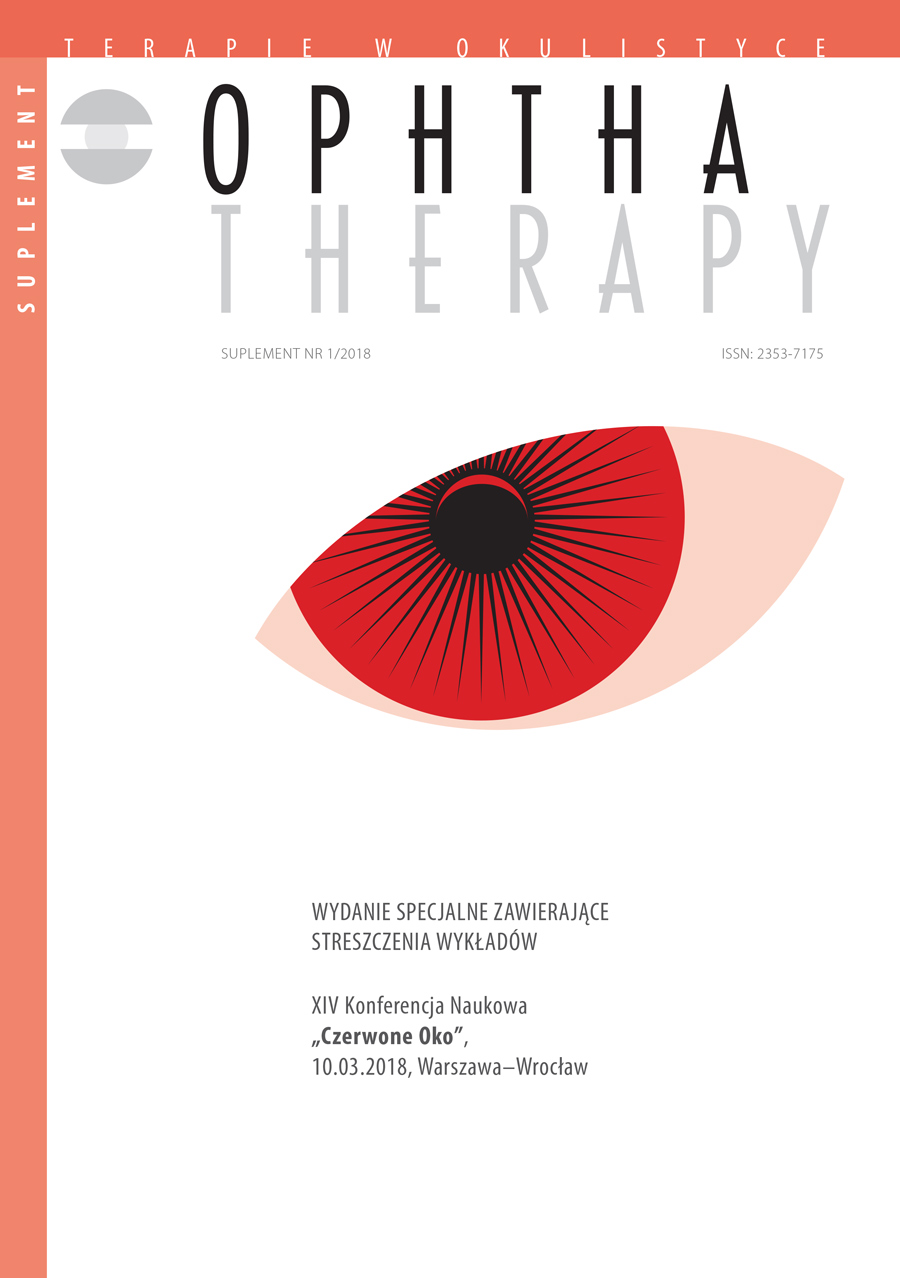Advantages of contemporary contactology
Main Article Content
Abstract
The dynamic development of contactology observed in recent years is the announcement of a real breakthrough in optical correction of visual defects. The projects of modern contact lenses go far beyond the basic indications for their application. Among the therapeutic indications, the participation of lenses in limiting the progress of myopia and the rehabilitation of the visually impaired deserve attention. The research on the use of contact lenses to measure tear film biomarkers seems promising, which will allow early diagnosis and monitoring of general diseases. Probably soon we will be able to apply the lenses as a drug carrier with a specific, individually matched release drug kinetics. The rapid development of electronics and miniaturization causes that era of intelligent lenses appears more probable and closer.
Downloads
Article Details

This work is licensed under a Creative Commons Attribution-NonCommercial-NoDerivatives 4.0 International License.
Copyright: © Medical Education sp. z o.o. License allowing third parties to copy and redistribute the material in any medium or format and to remix, transform, and build upon the material, provided the original work is properly cited and states its license.
Address reprint requests to: Medical Education, Marcin Kuźma (marcin.kuzma@mededu.pl)
References
2. Jones L, Luensmann D. Protein deposition on contact lenses: The past, the present, and the future. Contact Lens & Anterior Eye. 2012; 35: 53-64.
3. Ng A, Heynen M, Luensmann D et al. Impact of tear film components on conformational state of lysozyme deposited on contact lenses. J Biomed Mater Res Part B. 2013; 101B: 1172-81.
4. Schornack MM. Scleral lenses: a literature review. Eye & Contact Lens. 2015; 41: 3-11.
5. Kepecs MR, Boro A, Haut S. A novel nonpharmacologic treatment for photosensitive epilepsy: a report of three patient tested with blue cross-polarized glasses. Epilepsia. 2004; 9: 1158-62.
6. Park WL, Sunness JS. Red contact lenses for alleviation of photophobia in patients with cone disorders. Am J Ophthalmol. 2004; 137: 774-5.
7. Taibbi G, Wang ZI, Dell’Osso LF. Infantile nystagmus syndrome: Broadening the high-foveation- quality field with contact lenses. Clin Ophthalmol. 2008; 2: 585-9.
8. Eslani M, Baradaran-Rafii A, Movahedan A, Djalilian AR. The ocular surface chemical burns. J Ophthalmol. 2014; 2014: 196827. https://doi.org/10.1155/2014/196827.
9. Wu PC, Huang HM, Yu HJ et al. Epidemiology of myopia. Asia Pac J Ophthalmol. 2016; 5: 386-93.
10. Gifford P, Li M, Lu H et al. Corneal versus ocular aberrations after overnight orthokeratology. Optom Vis Sci. 2013; 90: 439-47.
11. Zhu M, Feng H, Zhu J, Qu X. The impact of amplitude of accommodation on controlling the development of myopia in orthokeratology. Zhonghua Yan Ke Za Zhi. 2014; 50: 14-9.
12. Walline JJ, Jones LA, Sinnott LT. Corneal reshaping and myopia progression. Br J Ophthalmol. 2009; 93: 1181-5.
13. Charm J, Cho P. High myopia-partial reduction ortho-k: a 2-year randomized study. Optom Vis Sci. 2013; 90(6): 530-9. https://doi.org/10.1097/OPX.0b013e 318293657d.
14. Sankaridurg P, Holden B, Smith E 3rd et al. Decrease in rate of myopia progression with a contact lens designed to reduce relative peripheral hyperopia: one-year results. Invest Ophthalmol Vis Sci. 2011; 52: 9362-7.
15. Loertscher M. Multifocal orthokeratology associated with rapid shortening of vitreous chamber depth in eyes of myopic children. Contact Lens Ant Eye. 2013; 36(Suppl 2): e2.
16. Chehab K, Shedden AH, Cheng J. Lens incorporating myopia control optics and muscarinic agents. U.S. patent 20140036225 A1, February 6, 2014.
17. Stone JL, Robin AL, Novack GD et al. An objective evaluation of eyedrop instillation in patients with glaucoma. Arch Ophthalmol. 2009; 127: 732-6.
18. Bobba S, Chow S, Watson S et al. Clinical outcomes of xeno-free expansion and transplantation of autologous ocular surface epithelial stem cells via contact lens delivery: a prospective case series. Stem Cell Res Ther. 2015; 6: 23.
19. Foulds WS, Barathi VA, Luu CD. Progressive myopia or hyperopia can be induced in chicks and reversed by manipulation of the chromaticity of ambient light. Invest Ophthalmol Vis Sci. 2013; 54: 8004-12.
20. Vincent SJ. The use of contact lenses in low vision rehabilitation: optical and therapeutic applications. Clin Exp Optom. 2017; 100(5): 513-21.
21. Vincent SJ. The use of contact lens telescopic systems in low vision rehabilitation. Cont Lens Ant Eye. 2017; 40: 131-42.
22. Dunbar GE, Shen BY, Aref AA. The Sensimed Triggerfish contact lens sensor: efficacy, safety, and patient perspectives. Clin Ophthalmol. 2017; 11: 875-82.
23. Vitish-Sharma P, Acheson AG, Stead R. Can the Sensimed Triggerfish lens data be used as an accurate measure of intraocular pressure? Acta Ophthalmol. 2018; 96: 242-8.
24. Kim D, Kim D, Lee H et al. Body-attachable and stretchable multisensors integrated with wirelessly rechargeable energy storage devices. Adv Mater. 2016; 28: 748-56.
25. Park J, Kim J, Kim SY et al. Soft, smart contact lenses with integrations of wireless circuits, glucose sensors, and displays. Sci Adv. 2018; 4: eaap9841.26.

